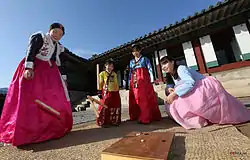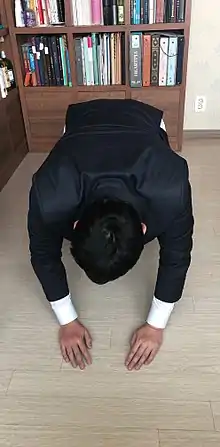Korean New Year
Korean New Year (Korean: 설날; RR: Seollal; MR: Sŏllal) is the first day of the Korean calendar. It is one of the most important traditional Korean holidays.[1][2] The celebration usually lasts three days: the day before Korean New Year, Korean New Year itself, and the day after Korean New Year. During this time, many Koreans visit family, perform ancestral rites, wear hanbok (한복), eat traditional food, and play folk games. Additionally, children often receive money from their elders after performing a formal bow.[3]
| Korean New Year | |
|---|---|
 | |
| Also called | Seollal |
| Observed by | Korean people around the world |
| Type | Cultural |
| Significance | First day of the Korean calendar |
| Date | Typically the second new moon after the winter solstice |
| 2020 date | January 25 |
| 2021 date | February 12 |
| Frequency | Annual |
| Related to | Chinese New Year, Japanese New Year, Mongolian New Year, Tibetan New Year, Vietnamese New Year |
Korean New Year generally occurs in January or February on the second new moon after the winter solstice, unless there is an intercalary eleventh or twelfth month in the lead-up to the New Year. In such a case, the New Year falls on the third new moon after the solstice.[4]
Names
Seollal generally refers to Eumnyeok Seollal (Hangul: 음력 설랄; Hanja: 陰曆설날, lit. "lunar new year"), also known as Gujeong (구정; 舊正). Seollal may also refer to Yangnyeok Seollal (양력 설날; 陽曆설날, lit. "solar new year" i.e. Gregorian new year on 1 January), also known as Sinjeong (신정; 新正).
While Korean New Year is generally referred to as Seollal, it has been called by many other names.[5] They are listed in the table below.[1]
| Literal translation | Hangul | Hanja | RR | MR |
|---|---|---|---|---|
| The first day | 원일 | 元日 | Wonil | Wŏnil |
| The first morning | 원단 | 元旦 | Wondan | Wŏndan |
| 원조 | 元朝 | Wonjo | Wŏnjo | |
| The first month | 원정 | 元正 | Wonjeong | Wŏnjŏng |
| The first new | 원신 | 元新 | Wonsin | Wŏnshin |
| The morning of the first month | 정조 | 正朝 | Jeongjo | Chŏngjo |
| The head of the year | 세수 | 歲首 | Sesu | Sesu |
| 연두 | 年頭 | Yeondu | Yŏndu | |
| 연수 | 年首 | Yeonsu | Yŏnsu | |
| The beginning of the year | 세초 | 歲初 | Secho | Sech'o |
| 연시 | 年始 | Yeonsi | Yŏnshi |
Origins
The earliest references to Korean New Year are believed to be found in the 3rd century Chinese historical work, Records of the Three Kingdoms, Book of Wei, Volume 30.[2][6] Records of 7th century Korean New Year celebrations are included in the Chinese historical works, the Book of Sui and the Old Book of Tang.[2] By the 13th century, Korean New Year was one of the nine major Korean festivals that included ancestral rites, according to the Korean historical work, the Goryeosa.[1]
Customs
_(4261102177).jpg.webp)
Korean New Year is typically a family holiday.[3] The three-day holiday is used by many to return to their hometowns to visit their parents and other relatives, where they perform an ancestral ritual called charye. The three days are the day of, the day before, and the after.[3] In 2016, 36 million South Koreans reportedly would be traveling to visit their families during the Korean New Year.[7] Koreans not only travel within the country, but around the world, as well. Many Koreans travel from overseas to visit their families for this annual holiday. Since it is one of the few times families may be able to get together and catch up on one another's lives, it is considered respectful and important to attend the holiday. Often, the family members first visit the elders, and this includes the grandparents and the parents. It is also considered respectful for people to visit their mothers- and fathers-in-law during the Korean New Year.[8]
Including travel expense, preparation for this holiday is very costly. Gifts are usually given to family members and new clothes are worn during the holiday. Traditional food is prepared for many family members coming to visit for the holiday. Fruits are especially expensive. Due to the increased demand, food prices are inflated during the month of Seollal. As a result, some people have chosen to forgo some traditions because they have become too expensive. These families prepare a modest ancestral rite only with necessary foods for Seollal The government has started taking certain measures to help stabilize and support ordinary people's livelihood for Seollal holiday period. They have raised the supply of agricultural, fishery, and livestock products. The government used rice reserves and pork imports to lower inflation. The government is also putting money into small and medium-sized companies to help with cash flow.
Many preparations go into celebrating the Korean New Year. During the first morning, Koreans pay their respect towards their ancestors. Traditional foods are placed on a table as an offering to the ancestors, and a rite begins with deep bows from all family members. This is a sign of respect and a very important practice on the first day of the New Year in Korea. It is also where they pray for the well-being of all the family members.[3] Many Koreans dress up in colourful traditional Korean clothing called hanbok. Hanbok is usually worn for special occasions such as weddings, Korean New Year, child's first birthday, etc.[3] However, with modernization and evolving mores in the culture, more people tend to prefer westernized, modern clothing to the hanbok. After the rite, the members have a big feast.
Additionally, Koreans follow a zodiac similar to the Chinese zodiac. Twelve (12) animals represent the 12 years in sequential order with the rat/mouse representing the first year. Buddha is believed to have invited animals from all over the world to visit, to which only 12 visited. In return, he honoured them by naming the years in the order that they arrived.[9] Koreans believe that specific zodiac animals bring specific resources and qualities. For example, the year 2014 was the year of the horse, and it was considered a good year in the money and career aspect of life. It is said that a person born in a specific zodiacal year will carry that zodiac animal's characteristics. As a result, Koreans plan their year and activities around it to have a good, prosperous year. Parents may have even planned the birth year of their child, so the child may have a specific characteristic. It is fair to say that the Korean zodiac is an important part of Korea's culture.[9]
Another custom observed is the lighting of a "moon house" built from burnable firewood and branches. This symbolizes the warding off of bad/evil spirits for the new year. Many also choose to add wishes they want to come true in the next year to the moon house.
Sebae

Sebae (세배, 歲拜, worship elders) is a ritual of filial piety that is traditionally observed on Seollal. Dressed in traditional clothing, children wish their elders (grandparents, parents and aunts and uncles) a happy new year by performing a deep traditional bow (rites with more than one bow involved are usually for the deceased) and the words saehae bok mani badeuseyo (Hangul: 새해 복 많이 받으세요), or "Please receive a lot of good fortune for the New Year". Elders typically reward this gesture by giving children new year's money, or "pocket money" called Sebaet Don (usually in the form of crisp paper money) in silk bags made with beautiful traditional designs, as well as offering words of wisdom (dŏkdam). Historically, parents gave out rice cakes (ddeok) and fruit to their children.
New Year food
Tteokguk
Tteokguk (soup with sliced rice cakes) is a traditional Korean food that is customarily eaten for the New Year. According to Korean age reckoning, the Korean New Year is similar to a birthday for Koreans, and eating tteokguk is part of the birthday celebration. Once you finish eating your tteokguk, you are one year older.
On Korean New Year day, people prepare a lot of food and spend much of the day with family.
Jeon
Jeon, sometimes called buchimgae, is a traditional Korean dish especially eaten on the Korean New Year's Day. A savory pancake, one would expect it to be sliced with a knife. However, the jeon is ripped apart with chopsticks in the belief of making it taste better.
Others
Other foods commonly prepared are mandu-guk, ddeok, galbi-jjim, and japchae.[10]
Folk games
Many traditional games are associated with the Korean New Year. The traditional family board game yutnori remains a popular game, especially during Korean New Year. It is played using a set of specially designed sticks and is considered appropriate for all ages and genders. Men and boys traditionally would also fly rectangle kites called Yeon (Hangul: 연, see yeonnalligi), and also play jegichagi, a game in which a light object is wrapped in paper or cloth, and then kicked in a footbag like manner. Korean women and girls would have traditionally played neolttwigi, a game of jumping on a seesaw (Hangul: 시소), and gongginori, a game played with five little gonggi (originally a little stone, but today many buy manufactured gongi in toy shops>). Top (paengi (Hangul: 팽이) in Korean) spinning is also a traditional game played by children. Recently, a few adults play Go-Stop instead of traditional hwatu.
See also
- Korean Calendar
- Celebrations of Lunar New Year in other parts of Asia:
- Chinese New Year (Spring Festival)
- Japanese New Year (Shōgatsu)
- Mongolian New Year (Tsagaan Sar)
- Tibetan New Year (Losar)
- Vietnamese New Year (Tết)
- Similar Asian Lunisolar New Year celebrations that occur in April:
- Burmese New Year (Thingyan)
- Cambodian New Year (Chaul Chnam Thmey)
- Lao New Year (Pii Mai)
- Sri Lankan New Year (Aluth Avuruddu)
- Thai New Year (Songkran)
References
- Encyclopedia of Korean Seasonal Customs. The National Folk Museum of Korea (South Korea). 2014. pp. 30–46. ISBN 978-8992128926.
- Kim, Myeong-ja (2010). 설 [Lunar New Year]. Encyclopedia of Korean Culture (in Korean). Academy of Korean Studies. Retrieved 2018-03-30.
- "Celebrating Seollal in Korea: Glimpse of Local New Year's Customs". Visit Korea. Korea Tourism Organization. 2018-02-02. Retrieved 2018-03-30.
- Crump, William D. (2014). Encyclopedia of New Year's Holidays Worldwide. McFarland. pp. 134–135. ISBN 978-1476607481.
- "설날" [Korean New Year]. Korea Cultural Heritage Foundation (in Korean). 2012-01-20. Retrieved 2018-03-30.
- "三國志/卷30" [Book of Wei, Volume 30]. Wikisource (in Chinese). Retrieved 2018-03-30.
- "Redirect Page".
- "Daughters-in-law vs. mothers-in-law". 8 February 2013.
- "The Seoul Times".
- Wolfe, Debbie (December 30, 2015). "SEOLLAL: KOREAN LUNAR NEW YEAR TRADITIONS AND FOOD". Crazy Korean Cooking. Retrieved June 10, 2020.